Naturally-occurring variations in climate (climate change) have occurred throughout history; however current climate warming has been linked to increased emissions of greenhouse gases, largely resulting from human activities. While greenhouse gases are naturally-occurring, increased emissions can lead to rapid warming as the gases trap more of the sun’s energy.
Soils play an important role in climate change because they can serve as both a source and sink for greenhouse gases, especially carbon dioxide (CO2), methane (CH4), and nitrous oxide (N2O). These gases are generated as natural by-products of soil microbial processes, including some of the same processes that provide plant-available nutrients and contribute to ecosystem stability (such as respiration and nitrification). However, if the equilibrium of these microbial processes is disrupted by a changing climate, the rate of greenhouse gas emissions could change rapidly.
More information on soil and climate change:

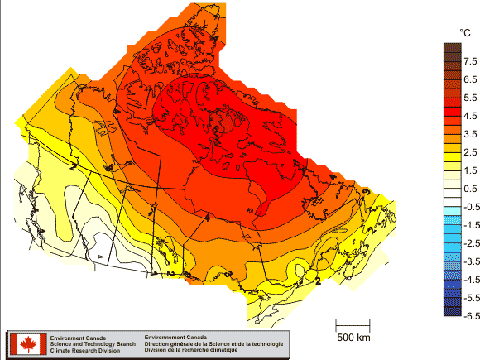
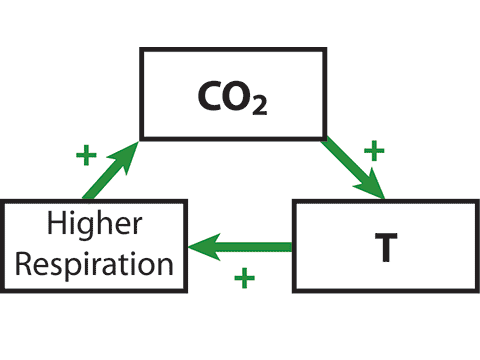
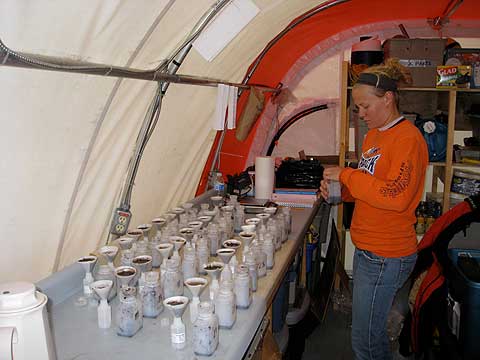
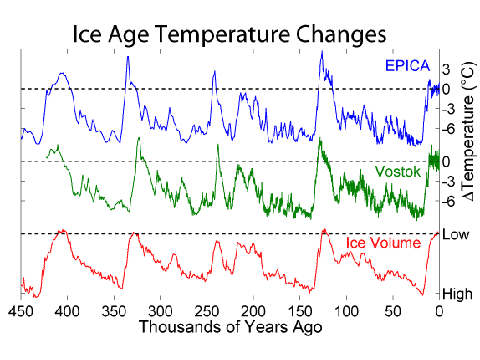
Many models predict that the polar regions will be more affected by climate change than other parts of the world. We can imagine two scenarios in the Arctic, one which is much warmer and a second that is warmer and much wetter than today.
In the first, a rapidly warming climate increases the activity of soil microorganisms, leading to increased greenhouse gas emissions (i.e. the soil would produce more greenhouse gases than it stores, becoming a “source”), and creating a positive feedback. More greenhouse gas emissions leads to more warming, and the cycle becomes more intense.
In the second scenario, a more wet and warm climate would allow microorganisms to produce more nutrients for plant uptake. Under these improved conditions, vegetation cover could increase on the Arctic tundra, allowing more vegetative uptake of carbon dioxide through photosynthesis and more carbon storage in soil organic matter. The soil acts as a “sink”, which could perhaps slow further warming – a negative feedback.
We can see that the interactions between soil and climate change are very complex! But not all soils behave the same way so we are faced with another challenge: how will different kinds of soils respond to changes in climate? Dr. Bedard-Haughn and her past graduate student Maxime Paré looked at how differences in soil characteristics along a slope may impact greenhouse gas emissions and climate change in the Arctic.
The International Polar Year was a major scientific research program focused on studying the Arctic and Antarctic (2007-2009). Scientists from around the world traveled to both ends of the earth in an effort to quantify the rapid changes occurring in the terrestrial (land) and marine (ocean) environments. As part of this initiative, Dr. Angela Bedard-Haughn and her Ph.D. student, Maxime Paré, traveled to sites from the High Arctic to the Sub-Arctic to look at what was happening in the soils.
In particular, they were interested in understanding the type of organic matter present in the soil and examining whether the type of organic matter found in the soil affects: 1) the kind of greenhouse gases that are emitted; 2) the total amount of greenhouse gas emissions; and 3) the rate of nitrogen cycling. The sites were located at Truelove Lowland on Devon Island, Nunavut, Daring Lake, Northwest Territories, and Churchill, Manitoba. At each site, they selected one or more toposequences, where the upper-slope soils were thin, relatively dry soils with minimal organic matter and the lower-slope soils were wet and often had thick layers of organic matter or peat at the surface. (Click here to see an example of a toposequence)
More information on soil and climate change:
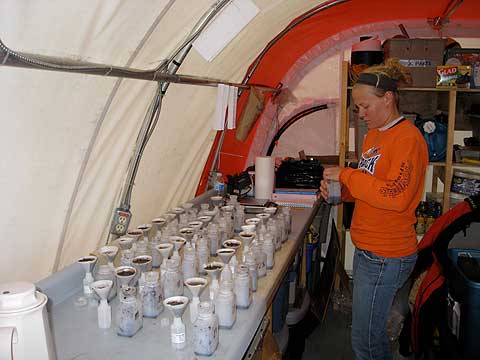

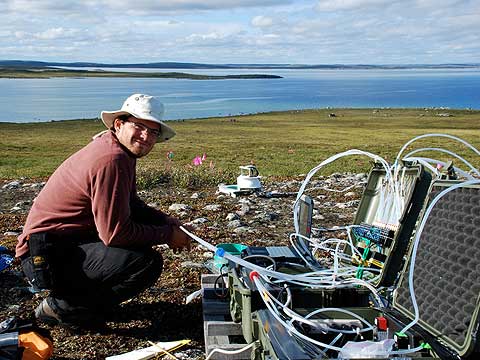

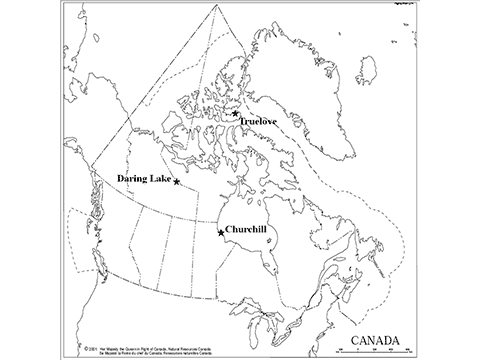
Along each toposequence, they established a series of transects (a transect is a line with points along it where samples are collected). At each sampling point, they measured greenhouse gas emissions coming from the soil and nitrogen mineralization (the amount of inorganic nitrogen produced). They also collected soil samples to determine a range of organic matter characteristics. These analyses were used to tell them whether the organic matter varied in terms of how labile (easily decomposed) or recalcitrant (very resistant to further decomposition) it was, and whether this property could be used to predict how much inorganic nitrogen would be available in the soil and/or how much greenhouse gases would be produced.
The results showed that the lower-slope soils had both the greatest amount of organic matter and the most labile organic matter. In addition, the soils from the southern-most sites (Churchill and Daring Lake) tended to have more labile organic matter than the High Arctic site (Truelove), suggesting that these soils will be most vulnerable to future changes in climate.
The research team included:
- Angela Bedard-Haughn
- Maxime Paré
More Resources
There are several interesting resources for learning about the earth’s past climate and atmospheric carbon dioxide.
Soil organic matter content greatly impacts many other soil properties, including water holding capacity and thermal (temperature) properties. It also has a significant impact on the
Soil water content is an important parameter that is routinely determined by soil scientists. Other parameters, such as organic matter content, will impact the soil’s ability to hold water.
Although we can’t see it, we can measure soil respiration. These two links provide instructions for running your own soil respiration experiment:
Arctic: A friend acting strangely is an excellent resource developed by the Smithsonian. The site contains background information on the arctic and relevant climate-related issues. There are several activities designed specifically for educators to incorporate into the classroom.
This video explains how methane trapped inside permafrost can enter the atmosphere during melting. It is a dramatic video that illustrates the presence of methane! Students will enjoy!
Prescribed learning outcomes (PLO) are content standards for the provincial education system; they are the prescribed curriculum. The “The Arctic Has Gas” research project and activities will help students to achieve the BC PLOs listed below.
PLOs are listed by code for different courses. Please consult the appropriate Integrated Resource Package (IRP) to identify the PLOs. A catalogue of the BC Curriculum Documents (including IRPs) can be found here: http://www.bced.gov.bc.ca/irp/all.php?lang=en#
- General Content
- Science 10 – Earth and Space Science: Energy Transfer in Natural Systems (D1-D3)
- Biology 11 – Ecology (D1)
- Earth Science 11 – Geological Time (D1); Surface Processes and the Hydrosphere (F1-F3)
- Geology 12 – Surface Processes and the Hydrosphere (F1, F4)
- Geography 12 – Themes and Skills (A2); Weather and Climate (D5, D7); Biomes (E3)
- Student Activities
- 1) Just resources, same PLOs as above
- 2) Measure soil organic matter content (same as #3 in MSS above)
- 3) Determine Soil Water Content (same as #3 in MSS above)
- 4) Soil Respiration Experiment
- Science 10 – Processes of Science (A1-A6); Physical Science: Chemical Reactions and Radioactivity (C1, C2, C4)
- Earth Science 11 – Surface Processes and the Hydrosphere (F1)
- Chemistry 11 – Skills and Processes of Chemistry (A1-A3); The Nature of Matter (B1, B5); Mole Concept (C2); Chemical Reactions (D1-D5)
- Chemistry 12 – Reaction Kinetics (A1, A2); Nature of Acids and Bases (D3); Applications of Acid-Base Reactions (F1)
- Geography 12 – Themes and Skills (A2-A4)
- 5) Exploring the Arctic (same as PLOs above)